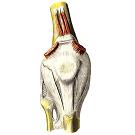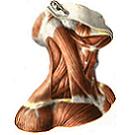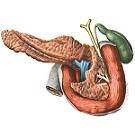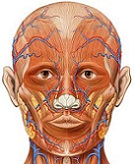Development and age features of the digestive system
The digestive system of a newborn is significantly different from that of adults.
The oral cavity develops from the oral bay covered with ectoderm, which gradually deepens and reaches the head end of the anterior bowel, here a combination of both embryonic leaves - ectoderm and endoderm. Above the oral cavity is limited by the frontal tubercle, which is formed due to active growth of the brain; From the lateral surfaces and from below the oral cavity is limited by visceral arches. Subsequently, these bones develop the bones of the face and organs of the oral cavity.
In the newborn, the oral cavity is very poorly developed. Further, with the development of the jaws, the eruption of teeth and the increase in the sky , the oral cavity gradually increases in size, the vestibule and the oral cavity itself form. On the eve of the mouth, the mucosa forms a series of folds: the frenum of the lips and the buccal cords, and on the hard palate - transverse folds. In a newborn and a child up to 2-3 years in the back of the hard palate, there are formations of epithelial tissue - strands lying on either side of the midline of the sky. The very firm sky of the newborn and in the first months of infants is significantly flattened, and its vagrancy is much weaker than in adults.
The entire oral cavity before the appearance of the vestibule completely fulfills the language , which in the newborn and in the first months of life is very wide and sharply flattened. It is laid out of several so-called lumbar tubercles - primordia, lying on the bottom of the primary oral cavity: one unpaired tubercle located along the median line and a pair of lateral tubercles. Bumps located in front of the blind hole develop into the body (back and top of the tongue), and the hillock, which lies behind the blind hole, is formed into the root of the tongue. All the listed rudiments of the tongue quickly fuse, leaving a trace - the boundary between the root and the body of the tongue in the form of a border groove. Ahead and along which lie gingival papillae. From the epithelial layer of the tongue the papillae of the tongue form: at the beginning appear gingival, leaf-shaped, and then mushroom-shaped and filiform. The muscles of the tongue develop from the myotomes of the occipital region, which grow into the thickness of the root of the tongue.
The oral cavity is divided into the mouth proper and the mouth of the mouth: gums, alveolar processes of the upper and alveolar part of the lower jaw, embedded teeth, initially dairy, and then permanent.
The laying of teeth occurs on the 2nd month of intrauterine life, while the enamel of the tooth is formed due to the ectoblast, and dentin, cement and pulp - due to the mesoblast. First, a dental plate appears, lamina dentalis. It grows into the underlying mesenchyme, which gives rise to the gingival ridges. Then on the dental plates protrusions are formed due to the growth of the epithelium - in this way the enamel organs of the baby teeth are formed. At the 10th week, they grow a mesenchyme, from which the dental papillae, papillae dentales, are formed. Subsequently, they partially separate from the dental plate, keeping with it the connection in the form of an epithelial strand. In addition, during the same period around the enamel organ, the surrounding mesenchyme thickens and a dental sac is formed, the sacculus dentis, merging with the dental papilla. All these transformations are observed at the first stage of development. At the second stage, further changes occur in the tooth rudiments: they separate from the dental plate, which loses its connection with the epithelium of the oral cavity. In the third stage, on the 4th month of embryonic development, dentin, enamel and dental pulp are formed.
The crown is formed before birth, and the development of the roots of the baby teeth ends after their eruption.
Terms for eruption of milk teeth: medial incisors - from 6th to 8th month; Lateral incisors - from 7th to 9th; The first indigenous - from the 12th to the 15th; Fangs - from 15th to 20th; The second indigenous - from the 20th to the 30th month; While the teeth of the lower jaw appear somewhat earlier than the corresponding ones on the upper jaw.
Salivary glands are a derivative of the epithelium of the oral cavity and differ little from those of an adult, but in the newborn large salivary glands: parotid, sublingual and submandibular - have a well expressed lobed structure.
The pharynx in the newborn, as well as in the adult, is divided into three parts: the upper part - the nasal, the middle - the oral and the lower - the throat. The nasopharynx in early childhood does not have a highly curved arch, it is more flattened; Hoans, through which the nasal cavity communicates with the nasopharynx, very narrow. The opening of the auditory tube in the newborn and in early infancy is located at the level of the hard palate, while in the adult - at the posterior end of the inferior nasal concha. This is due to the development of the upper jaw and the lowering of the bottom of the nasal cavity.
In a newborn, the place where the pharynx passes into the esophagus corresponds to the level of the IV-V cervical vertebra , in the adult - to the level of the sixth cervical vertebra.
The pharyngeal tonsil is poorly developed, variable in shape and often rapidly increases in size.
The esophagus is placed simultaneously with the respiratory organs from the anterior parts of the intestinal tube. In newborns, it begins at the level of IV-V cervical vertebrae and differs from the adult's esophagus in its form - it is funnel-shaped. Its length varies from 10 to 16 cm, to 2 years it reaches 20 cm.
In the newborn, the neck part of the esophagus is slightly higher than in the adult, but with age it drops, especially intensively to 10-12 years. The wealth of adventitial tissue in the esophagus wall in the newborn and infants determines the great mobility of the esophagus, although its muscular layers are still poorly developed. Transition of the esophagus into the stomach in newborns is projected at the level of X-XI thoracic vertebrae .
Stomach is formed from the posterior part of the anterior gut. At the 4th week of embryonic development, it has the appearance of spindle-shaped enlargement and gradually grows in width. Age features of the shape and position of the stomach are characterized by the fact that in the newborn the convexity of the arch and large curvature is poorly expressed and the shape of the stomach approaches the cylindrical and the position is almost vertical. In a newborn stomach capacity varies from 30-35 to 150 cm 3 , but it increases rapidly and reaches 300 cm 3 by the year. After birth, the position of the stomach changes: gradually falls. In the newborn, the cardiac part is located at the level of VIII-IX thoracic vertebrae, the doorkeeper - XI-XII vertebrae.
In infants, the shape of the stomach approaches the pear-shaped, it is located more horizontally and higher due to its mixing with swollen intestinal loops; At the same time, this position, apparently, depends more on the degree of its rotation in embryogenesis. The shape and position of the stomach can change under the influence of filling both the stomach itself and the organs adjacent to it. In children, the stomach is almost completely covered with the liver.
The intestine from the pyloric part of the stomach to the cloaca develops at the end of the first month of intrauterine life from the primary intestinal tube. The primary intestine forms a loop, the anterior knee of which is differentiated into the duodenum, lean, and most of the ileum. A terminal site of the ileum, a cecum with a vermiform appendage and the entire colon to the anus are formed from the posterior lobe.
The duodenum of the newborn has distinctive features. It is most often ring-shaped, without visible boundaries between the parts. By 2-3 years, this form is observed much less often, and the shape of the bowel is closer to that of an adult. In the newborn, the beginning of the intestine and its end (twelve perforating bend) lie almost on the same level, with the upper part of the intestine being higher than that of the adult. With age, starting from the 5th-6th month of life, this part of the intestine descends to the level of the XII thoracic vertebra; Lowering continues to the body I of the lumbar vertebra.
The intensive growth of the primary intestinal tube causes the formation of a number of intestinal loops, the position of which in the abdominal cavity can be vertical or horizontal, depending on the location of the root of the mesentery - horizontal or vertical. The mesentery of the mesentery in the newborn is located quite high: the beginning - at the level I of the lumbar vertebra, the end - at level IV. In the future there is a gradual lowering of the intestine. In the period from 1 to 3 years and from 10 to 15 years, the fastest growth of the intestinal tract is observed. The relative length of it decreases with age. Thus, in the newborn, its length is relatively large, it is 6-7 times greater than the length of the body, and in the adult it is 3-4.5 times.
You will be interested to read this:









Comments
When commenting on, remember that the content and tone of your message can hurt the feelings of real people, show respect and tolerance to your interlocutors even if you do not share their opinion, your behavior in the conditions of freedom of expression and anonymity provided by the Internet, changes Not only virtual, but also the real world. All comments are hidden from the index, spam is controlled.